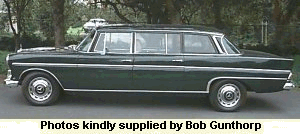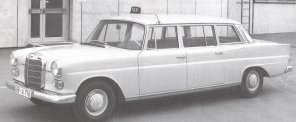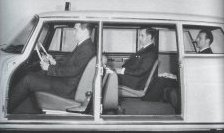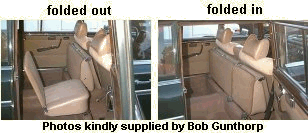
|
 |
After Mercedes let IMA build the Universal cars, Binz decided to design
a seven seater Heckflosse. In May 1967 Binz came up with a seven seater on basis of the
200D and very rarely the 230 cars. The 200D LWB was only supplied with a standard
transmission. Like the ambulances and Universal cars, the seven seaters were equipped with
15in wheels. The self-levelling strut on the rear axle was also standard but power
steering was not.
The Diesel engine car didn't supply enough power to pull the extra 140 kg in weight and
although it claimed a top speed of 125 km/h, such a speed was only realistically
obtainable on a long motorway run, especially when the car was carrying seven passengers. |
 The seven seater Heckflosse
had its wheelbase extended by no less than 65 cm so that a third row of seats could be
fitted in the middle. The seven seater Heckflosse
had its wheelbase extended by no less than 65 cm so that a third row of seats could be
fitted in the middle.
The example shown here is equipped with extra chrome trim. Standard LWB cars did not have
the chrome wheelarches or the horizontal chrome trim along the side.
|
 The extra row of seats
allowed the car to be used as a taxi. On the right you see an example of a taxi painted in
the standard taxi colour ivory, early taxis were painted black. Some hotels were
interested in a car who could pick up a large number of hotel guests from the airport,
bring them to the hotel and who could bring them back again to the airport and this car
could do the trick. The extra row of seats
allowed the car to be used as a taxi. On the right you see an example of a taxi painted in
the standard taxi colour ivory, early taxis were painted black. Some hotels were
interested in a car who could pick up a large number of hotel guests from the airport,
bring them to the hotel and who could bring them back again to the airport and this car
could do the trick.
|
  Here you see how the middle row of seats was fitted. Here you see how the middle row of seats was fitted.
The seat could be folded in to let rear passengers enter and leave easliy. The seat was
divided in a 1:2 ratio.
|
Although these cars were designed at Binz, they were built at the
Mercedes-Benz factory and not by Binz. The quality of the parts made by Binz are not
always up to Mercedes-Benz standard it appears. An owner of two cars bodied by Binz tells
me that you can clearly tell which parts of the vehicle were built by Daimler-Benz and
which parts were built by Binz |
Production stopped after just nine months when Mercedes decided to
replace the 200D and 230 with its new mid-range saloons, the W114 and W115 cars. That is
why these models remaine quite rare, its not clear how many of these cars were built, but
there can't have been many. It is said that the number stops at 188, how many cars have
survived remains a guess. |
Bob Gunthorp has not only provided me some great pictures of his car,
he also knows a story about the evolution of these cars. This story was told to by a man
who was a zone manager for MBNA ( Mercedes Benz North America) at the time the cars were
built. You may choose to believe the story or not, either way its a great story !
"In New Jersey USA in the early 60's there was a very well to do Mercedes Benz
dealer. Every year he made a pilgrimage the the holy land. He would fly in to Haifa
Israel. Well, the airport in Haifa was many kilometers from the city. It would require two
taxis (Mercedes Benz 200 D's of course) to get him and his family to the city. He felt
that Mercedes Benz should build a taxi that would hold 7 passengers. That way his family
could ride together to the city.
He was able to exert some pressure on the factory to start production of the LWB cars. The
factory was probably pursuing the idea on their own at the time.
When the cars were built they became known in MBNA's home offices as the 'Haifa Taxis'
".
Bob knows this because the has met the man in question, the first time he saw his 200 D
LWB he started laughing loudly and pointed at the car and said 'You own a "Haifa
Taxi' ". When asked what he was talking about he told Bob the story above."
|